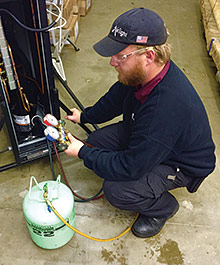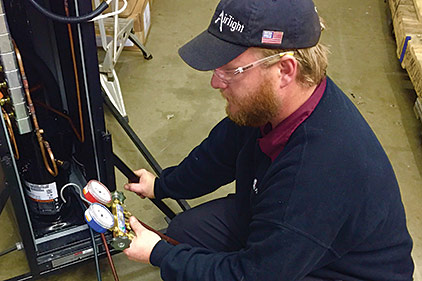
|
| Ryan Brown, a technician for AirTight Mechanical in Charlotte, North Carolina, services a portable R-22 system used for data center hot spots. (Photo courtesy of AirTight Mechanical) |
In October 2014, the U.S. Environmental Protection Agency (EPA) finalized its plan for phasing out hydrochlorofluorocarbon (HCFC)-22, or R-22, by 2020. The plan called for a drastic cut in R-22 production and importation in 2015 followed by a linear phaseout between 2015 and 2020.
While the EPA allowed 51 million pounds in 2014, it is only allowing 22 million in 2015, 18 million in 2016, 13 million in 2017, 9 million in 2018, and 4 million in 2019. After that, new or imported R-22 will be banned in the U.S. due to its harmful effects on
the environment.
Meanwhile, proactive HVAC contractors have been working to educate their employees and clients on the inevitable phaseout. And, with the price of R-22 already starting to rise in many areas, educated contractors are finding it easier to convince customers to replace aging R-22 units with newer, more efficient models.
Making an Adjustment
For many contractors, the phaseout schedule has already had an impact on business. Many have already begun training staff and educating customers as the supply of virgin R-22 begins to dwindle.
Steve Moon, owner, Moon Air Inc., Elkton, Maryland, said the phaseout is interruptive. “First, it is good for Mother Earth,” he said. “Second, it has been forced on us, so we have to comply. So, let’s move forward as an industry and do the right thing by everyone. The biggest problem is our industry is full of guys who have been doing the same thing the same way for many years. We are creatures of habit. Change is painful.”
Jim Crews, service/sales, project manager, Environmental Conditioning Systems, Mentor, Ohio, said the company stays current on the best new refrigerants and equipment because it is what’s best for business.
“Our techs are aware of new refrigerants and have been trained on the different new oils. All the necessary instruments and tools are already on the trucks,” Crews said. “Business-wise, buying the dry-shipped equipment, connecting, and charging with R-22 is not good advice for the customer; this perpetuates old technology and exposes them to uncontrolled repair costs as the phaseout continues.”
Butch Welsch, owner, Welsch Heating and Cooling Co., St. Louis, said his company is cautioning customers who wish to order dry-shipped R-22 equipment.
“We have installed virtually no dry-charge units as of late because, in my opinion, they are against the spirit of the regulation, if not the word,” he said. “[The phaseout] was mandated, so it is our obligation to abide by it. That’s what we have done.”
Bobby Ring, president, Meyer & Depew Co., Kenilworth, New Jersey, said the phaseout has been “years in the making,” and contractors need to learn to adjust. “Science says eliminating R-22 will be good for the environment. This was all decided a long time ago by folks who have the education and credentials to support the conclusions they reached.”
Ann Kahn, president, Kahn Mechanical Contractors, Dallas, said the phaseout is good for both the environment and contractors alike. “It has been proven time and time again that we are creating the problem of global warming ourselves,” she said. “It’s not a big change. Most people are aware of the situation through newspaper articles, TV specials, and other publicity.”
Tim Paetz, general manager and co-owner, Bud Anderson Heating and Cooling, Lowell, Arkansas, is glad the U.S. is phasing out the production and importation of R-22.
“We’ve been talking about it for more than 20 years, and we trained our technicians for years to educate customers about the phaseout,” Paetz said. “We leave all the old dinosaur equipment in the past and have to carry fewer parts. R-410A is higher efficiency, and, by now, we’ve worked out all the bugs.”
Greg Crumpton, president, AirTight Mechanical, Charlotte, North Carolina, also agreed the phaseout is a good plan, though he said the timeframe doesn’t seem logical.
“There are millions of systems out in the real world that utilize R-22; these will continue for a long time, and, obviously, how well these systems are cared for will ultimately dictate their replacement,” he said. “I think it is an aggressive schedule, but, overall, I support it, for sure.”
Rising Prices?
The most immediate fallout from the phaseout in 2015 will be the rising cost of R-22 across much of the nation.
“My business is affected mostly due to the volatility of the actual gas pricing — not only from our supplier, which is predominately C.C. Dickson Co., but also from the OEM of the gases forcing the issue at the wholesale level,” Crumpton said. “Prices soared upon the release of the [phasedown] schedule, but, like most things, [it will come] back to an equilibrium that the market will support. The import gases, legal or not legal, affect what the market will tolerate, as well.”
“The pricing keeps rising,” Kahn said.
Crews said the price has gone up 23 percent, and, according to Welsch, the worst is yet to come.
“We paid $198 per jug for a skid of R-22 in October 2014,” Welsch said. “We checked pricing today at two locations and we’ve been told $240 — but subject to increasing to $295 at any moment. And, another vendor quoted us at $293. We were told it is anticipated to be at $400-$450 per jug by summer. That’s quite an increase. However, they told us last year it was going to increase dramatically, and it never did. As we do with any change such as this, we believe strongly in communicating to everyone, including employees and customers, exactly what is happening and what we know.”
Prices haven’t jumped unilaterally, however. Moon said he “has not seen a change as of yet,” and Paetz said prices have remained stable for the last quarter.
Residential Versus Commercial
Contractors in the commercial market may have a harder time adjusting to the phaseout due to the rising cost of R-22 and the prevalence of the refrigerant in commercial equipment.
“I believe commercial contractors are affected more only because there are a greater percentage of commercial clients still heavily invested in R-22 systems, and those systems generally use larger quantities of R-22,” Ring explained. “I would estimate that 60 percent of our residential clients and 80-90 percent of our commercial clients still have R-22 systems.”
“In the future, obviously, the cost to replace equipment in order to go to R-410A will be much higher with rooftop units and other similar commercial pieces of equipment,” Welsch agreed.
Additionally, the cost of retrofitting equipment to use a new refrigerant is higher for commercial contractors, Crews said. “The equipment cost, labor, and materials [required] to change from R-22 to a new refrigerant far exceed those of residential,” he said.
Moon agreed: “Their [residential contractors] volume of R-22 per system is drastically higher. They have some very good drop-in replacements that work well, and there should be very few problems.”
Crumpton, however, said residential and commercial contractors are affected equally by the phaseout. “We are all dealing with the same stuff and issues,” he said. “The residential guys have to have the same conversation with their customers — they just have to do it a lot more often.”
Incentive to Convert
Rising costs to charge and maintain R-22 equipment have provided forward-thinking contractors with plenty of ammunition to help convert customers to newer refrigerants and equipment.
“Upwards of 75 percent of the equipment we service still runs on R-22,” Kahn said. “Customers are always offered equipment with alternative refrigerants. If they refuse, which they often do, they are advised that virgin R-22 is scarce, and reclaimed refrigerant will soon be all that is available — at a very steep cost.”
“I would estimate that we service a fleet of equipment that is 85-90 percent R-22-based,” Crumpton said. “The phaseout plan makes us think ahead and discuss with the end user the benefit of repair or replacement. Many times, the severity of the issue will drive the decision. Small leaks or major component failures — each will require a different discussion.”
Crews estimates 50-60 percent of the equipment they service still runs on R-22. Phasing out the refrigerant has presented the opportunity to generate new equipment sales as well as make a name for the company as a leader in the industry, he said.
“It’s actually helped customers with the decision to replace equipment near the end of its service life instead of repairing,” Crews said. “Although, initially, the refrigerant leaks on new condensing units with the higher running pressures have been difficult to understand and costly for us and customers.”
Moon also said the phaseout has created replacement opportunities that may not have been there before.
“In the residential world, we see a lot of R-22 systems,” he said. “With the cost of gas rising, systems will be replaced with R-410a earlier than they used to. When the repair costs exceed the system’s worth, it’s time for it to go. It’s made us focus on complete system changeouts instead of just an outdoor unit changeout, which the white-van guy loves to do. They are cheap, but definitely not in the client’s best interest.”
Parting Advice
For many contractors, the release of the phasedown schedule late last year has provided a better idea of what to expect and how to plan for it over the next few years. A big part of that preparation, they stressed, is education.
“Start educating your clients on smaller carbon footprints,” Paetz advised. “Just knowing this issue will finally be done will affect us in a positive way. Before, when the EPA went back on the phaseout and delayed whether or not it was going to allow dry R-22 units — this was a big letdown to us. We want to do the right thing.”
Crumpton also advised educating customers about the phaseout as soon as possible. “Educate your people and customers as to when is the right time for a system upgrade. There are so many moving parts to the equation — tubing sizes, cabinet and coil sizes, etc. Essentially, there is no standard answer, so work on each opportunity to find the best and most timely answer for each situation.”
Ring also advised other contractors to “get out in front of the issue with clients and employees,” and Welsch said to be open and communicate what you know to customers and employees.
“Get training,” Moon added. “Our vendors are happy to help us understand and comply. Ask for help. This is nothing new, since we went through the R-12 phaseout. I think contractors are far less fearful and ready to accept it.”
Finally, Crews said, while there are some exceptions, contractors should strive not to perpetuate the use of R-22.
“We will all miss the reliability and simplicity of R-22 and mineral oil, as we did with R-12,” he said. “But, we survived R-12 being gone, and we will do so with R-22, too.”
Publication date: 2/9/2015
Want more HVAC industry news and information? Join The NEWS on Facebook, Twitter, and LinkedIn today!



Report Abusive Comment